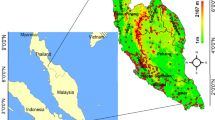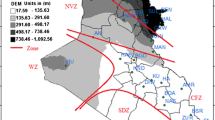Abstract
Estimating precipitation over large spatial areas remains a challenging problem for hydrologists. Satellite-based remote sensing rainfall products have the advantage of large-scale synchronous coverage, but the reliability of their inversion still needs to be improved. Correcting the bias of satellite-based precipitation estimates (SPEs) is a major challenge in applications such as environmental modeling, hydrology, and water resource management. In this paper, a new bias correction method—a Gaussian process regression (GPR) model method based on rain intensity classification—is proposed to improve the accuracy of a satellite precipitation product—the Integrated Multi-satellite Retrievals for GPM (IMERG) Final Run (FR) product—at the daily scale in the Guangdong-Hong Kong-Macao Greater Bay Area. By comparing the effects of the proposed method with those of other existing classical correction methods, namely, quantile mapping (QM), the support vector machine (SVM) approach and direct GPR, it is found that all four methods improve the accuracy of the FR product to varying degrees. GPR based on rain intensity classification has the best effect of FR product improvement, with the CORR increasing from 0.55 to 0.59, the RMSE ranging from 14.37 to 12.79 mm/day, and the BIAS ranging from − 0.14 to 0.03 during the validation period. GPR without rain intensity classification also yields good results, with the QM and SVM methods being the least effective.









Similar content being viewed by others
Data availability
The datasets used in the present study are freely available: (i) The daily rain gauge observations are freely available for download on http://data.cma.cn/. (ii) The latest IMERG V05 product is freely available for download on https://pmm.nasa.gov/GPM.
Code availability
Not applicable.
References
Abera W, Brocca L, Rigon R (2016) Comparative evaluation of different satellite rainfall estimation products and bias correction in the Upper Blue Nile (UBN) basin. Atmos Res 178:471–483
Baez-Villanueva OM, Zambrano-Bigiarini M, Beck HE, Mcnamara I, Ribbe L, Nauditt A, Birkel C, Verbist K, Giraldo-Osorio JD, Xuan, Thinh N (2020) RF-MEP: A novel random forest method for merging gridded precipitation products and ground-based measurements. Remote Sens Environ 239:111606
Blix K, Eltoft T (2018) Evaluation of feature ranking and regression methods for oceanic chlorophyll-a estimation. IEEE J-STARS 11(5):1403–1418
Boushaki FI, Hsu K, Sorooshian S, Park G, Mahani S, Shi W (2009) Bias adjustment of satellite precipitation estimation using ground-based measurement: a case study evaluation over the southwestern United States. J Hydrometeorol 10(5):1231–1242
Chen ST, Yu PS, Tang YH (2010) Statistical downscaling of daily precipitation using support vector machines and multivariate analysis. J Hydrol 385(1–4):13–22
Chen J, Brissette FP, Chaumont D, Braun M (2013) Finding appropriate bias correction methods in downscaling precipitation for hydrologic impact studies over North America. Water Resour Res 49(7):4187–4205
Chen H, Yong B, Gourley JJ, Liu J, Ren L, Wang W, Hong Y, Zhang J (2019) Impact of the crucial geographic and climatic factors on the input source errors of GPM-based global satellite precipitation estimates. J Hydrol 575:1–16
Choubin B, Khalighi-Sigaroodi S, Mishra A, Goodarzi M, Shamshirband S, Ghaljaee E, Zhang F (2019) A novel bias correction framework of TMPA 3B42 daily precipitation data using similarity matrix/homogeneous conditions. Sci Total Environ 694:133680
De Vera A, Terra R (2012) Combining CMORPH and rain gauges observations over the Rio Negro Basin. J Hydrometeorol 13(6):1799–1809
García-Floriano A, López-Martín C, Yáñez-Márquez C, Abran A (2018) Support vector regression for predicting software enhancement effort. Inform Software Tech 97:99–109
Huffman GJ (2017) NASA Global Precipitation Measurement (GPM) Integrated Multi-satellitE Retrievals for GPM (IMERG)
Ireland G, Volpi M, Petropoulos G (2015) Examining the capability of supervised machine learning classifiers in extracting flooded areas from Landsat TM Imagery: a case study from a Mediterranean flood. Remote Sens 7(3):3372–3399
Kumar D et al (2017) Evaluation of TRMM multi-satellite precipitation analysis (TMPA) against terrestrial measurement over a humid sub-tropical basin, India. Theor Appl Climatol 129:783–799
Lafon T, Dadson S, Buys G, Prudhomme C (2013) Bias correction of daily precipitation simulated by a regional climate model: a comparison of methods. Int J Climatol 33(6):1367–1381
Lary DJ, Alavi AH, Gandomi AH, Walker AL (2016) Machine learning in geosciences and remote sensing. Geosci Front 7(1):3–10
Lee J, Lee E, Seol K (2019) Validation of Integrated MultisatellitE Retrievals for GPM (IMERG) by using gauge-based analysis products of daily precipitation over East Asia. Theor Appl Climatol 137:2497–2512
Li N, Tang G, Zhao P, Hong Y, Gou Y, Yang K (2017) Statistical assessment and hydrological utility of the latest multi-satellite precipitation analysis IMERG in Ganjiang River basin. Atmos Res 183:212–223
Li C, Sinha E, Horton DE, Diffenbaugh NS, Michalak AM (2014) Joint bias correction of temperature and precipitation in climate model simulations. J Geophys Res-Atmos 119(23):13, 113–153, 162
Liang Y, Jiang C, Ma L, Liu L, Chen W, Liu L (2017) Government support, social capital and adaptation to urban flooding by residents in the Pearl River Delta area, China. Habitat Int 59:21–31
Liu C, Yu M, Cai H, Chen X (2019) Recent changes in hydrodynamic characteristics of the Pearl River Delta during the flood period and associated underlying causes. Ocean Coast Manag 179:104814
Lu X, Tang G, Wang X, Liu Y, Jia L, Xie G, Li S, Zhang Y (2019) Correcting GPM IMERG precipitation data over the Tianshan Mountains in China. J Hydrol 575:1239–1252
Ma Y, Zhang Y, Yang D, Farhan SB (2015) Precipitation bias variability versus various gauges under different climatic conditions over the Third Pole Environment (TPE) region. Int J Climatol 35(7):1201–1211
Ngai ST, Tangang F, Juneng L (2017) Bias correction of global and regional simulated daily precipitation and surface mean temperature over Southeast Asia using quantile mapping method. Global Planet Change 149:79–90
Pan Y, Gu JX, Xu B, Shen Y, Han S, Shi CX (2018) Advances in multi-source precipitation merging research. Adv Meteorol Sci Technol 8(01):143–152 (In Chinese)
Piani C, Haerter JO, Coppola E (2010) Statistical bias correction for daily precipitation in regional climate models over Europe. Theor Appl Climatol 99(1–2):187–192
Schulz E, Speekenbrink M, Krause A (2018) A tutorial on Gaussian process regression: modelling, exploring, and exploiting functions. J Math Psychol 85:1–16
Smola AJ, Schlkopf B (2004) A tutorial on support vector regression. Stats Comput 14(3):199–222
Su J, Lü H, Zhu Y, Cui Y, Wang X (2019) Evaluating the hydrological utility of latest IMERG products over the Upper Huaihe River Basin, China. Atmos Res 225:17–29
Tan W, Zeng Ch, Shen HF (2020) Gaussian process regression algorithm based method for merging daily-scale IMERG and gauge precipitation data: a case of Hubei Province. J Centr China Norm Univ Nat Sci 3(54):439–446
Tao Y, Gao X, Hsu K, Sorooshian S, Ihler A (2016) A deep neural network modeling framework to reduce bias in satellite precipitation products. J Hydrometeorol 17(3):931–945
Tong Y, Gao XJ, Han ZY, Xu Y (2017) Bias correction of daily precipitation simulated by RegCM4 model over China. Chin J Atmos Sci 41(6):1156–1166 (In Chinese)
Tripathi S, Srinivas VV, Nanjundiah RS (2006) Downscaling of precipitation for climate change scenarios: a support vector machine approach. J Hydrol 330(3–4):621–640
Vapnik V (2013) The nature of statistical learning theory. Springer Science & Business Media, New York
Villanueva O, Giraldo-Osorio JD, Ortiz L (2016) Bias correction of the rainfall CMORPH satellite product using observed data from Bogotá, Colombia. NOVATECH
Wang R, Chen J, Wang X (2017) Comparison of IMERG Level-3 and TMPA 3B42V7 in estimating typhoon-related heavy rain. Water 9(4):276
Wu LZP (2012) Validation of daily precipitation from two high-resolution satellite precipitation datasets over the Tibetan Plateau and the regions to its east. Acta Meteorol Sin 26(6):735–745
Xu L, Chen N, Zhang X, Chen Z, Hu C, Wang C (2019) Improving the North American multi-model ensemble (NMME) precipitation forecasts at local areas using wavelet and machine learning. Clim Dynam 53(1–2):601–615
Yang Z, Hsu K, Sorooshian S, Xu X, Braithwaite D, Verbist KMJ (2016) Bias adjustment of satellite-based precipitation estimation using gauge observations: a case study in Chile. J Geophys Res-Atmos 121(8):3790–3806
Yang Z, Hsu K, Sorooshian S, Xu X, Braithwaite D, Zhang Y, Verbist KMJ (2017) Merging high-resolution satellite-based precipitation fields and point-scale rain gauge measurements-a case study in Chile. J Geophys Res-Atmos 122(10):5267–5284
Yao X, Crook J, Andreeva G (2017) Enhancing two-stage modelling methodology for loss given default with support vector machines. Eur J Oper Res 263(2):679–689
Zhang X, Tang Q (2015) Combining satellite precipitation and long-term ground observations for hydrological monitoring in China. J Geophys Res-Atmos 120(13):6426–6443
Zhang W, Wang W, Zheng J, Wang H, Wang G, Zhang J (2015) Reconstruction of stage–discharge relationships and analysis of hydraulic geometry variations: the case study of the Pearl River Delta, China. Global Planet Change 125:60–70
Zhao H, Yang B, Yang S, Huang Y, Dong G, Bai J, Wang Z (2018) Systematical estimation of GPM-based global satellite mapping of precipitation products over China. Atmos Res 201:206–217
Acknowledgements
The authors would like to thank the developer of IMERG products for providing the data freely available to public.
Funding
This work was supported by the National Key Research and Development Program of China (No. 2017YFC1502702), the Science and Technology Program of Guangdong Province (No. 2020B1515120079), and the Professorial and Doctoral Scientific Research Foundation of Huizhou University (No. 2021JB014).
Author information
Authors and Affiliations
Contributions
All authors contributed to the study conception and design. Xue Li: data curation, formal analysis, visualization, software, and writing—original draft preparation. Yueyuan Zhang: software and revision of the article. Lingfang Chen: revision of the article. Yangbo Chen: supervision. All authors read and approved the final manuscript.
Corresponding author
Ethics declarations
Ethics approval
This research did not involve human subjects. Meteorological datasets used in this study can all be obtained from publicly accessible archives.
Consent to participate
This research did not involve human subjects.
Consent for publication
This research did not involve personal information for which consent was to be sought.
Conflict of interest
The authors declare no competing interests.
Additional information
Publisher's note
Springer Nature remains neutral with regard to jurisdictional claims in published maps and institutional affiliations.
Rights and permissions
Springer Nature or its licensor (e.g. a society or other partner) holds exclusive rights to this article under a publishing agreement with the author(s) or other rightsholder(s); author self-archiving of the accepted manuscript version of this article is solely governed by the terms of such publishing agreement and applicable law.
About this article
Cite this article
Li, X., Chen, Y., Zhang, Y. et al. Bias adjustment of satellite rainfall data through Gaussian process regression (GPR) based on rain intensity classification in the Greater Bay Area, China. Theor Appl Climatol 152, 1115–1127 (2023). https://doi.org/10.1007/s00704-023-04435-y
Received:
Accepted:
Published:
Issue Date:
DOI: https://doi.org/10.1007/s00704-023-04435-y




